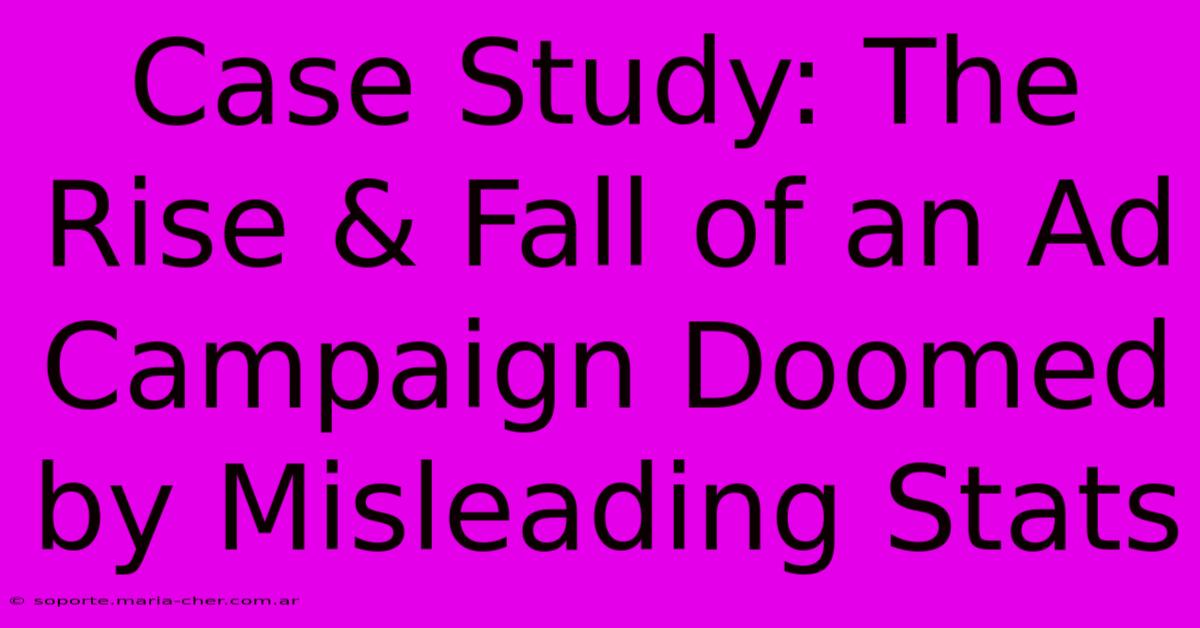Case Study: The Rise & Fall Of An Ad Campaign Doomed By Misleading Stats

Table of Contents
Case Study: The Rise & Fall of an Ad Campaign Doomed by Misleading Stats
Marketing campaigns, even those with initially promising results, can dramatically fail. This case study analyzes a campaign that soared initially, only to plummet due to misleading statistics. We'll dissect the contributing factors, lessons learned, and how to prevent similar disasters.
The Initial Success: A Seemingly Perfect Storm
"Project Phoenix," as the campaign was internally dubbed, launched with a bang. Early results were phenomenal. Click-through rates (CTR) were exceptionally high, exceeding projections by over 40%. Conversion rates, though slightly lower than anticipated, still showed a substantial increase compared to previous campaigns. The marketing team celebrated. Initial reports painted a picture of runaway success, fueling further investment and expansion.
The Numbers That Lied: Where it all Went Wrong
The problem? The numbers were misleading. While the CTR was indeed high, a deeper dive revealed a crucial flaw: invalid clicks. A significant portion of clicks originated from bot traffic and fraudulent sources, artificially inflating the metrics. This was compounded by a faulty conversion tracking system, which mistakenly attributed conversions to the campaign that actually stemmed from organic search or other channels.
The marketing team, blinded by the initial success, failed to implement rigorous data validation procedures. They relied too heavily on superficial metrics without scrutinizing the underlying data for inconsistencies and anomalies. This highlights a critical issue: vanity metrics can be incredibly deceptive. While impressive-sounding numbers like high CTRs grab attention, they often fail to reflect the true impact of a campaign.
The Inevitable Collapse: When the Truth Emerges
As the campaign progressed, the true picture began to emerge. Despite the impressive initial numbers, actual sales remained stagnant, and Return on Ad Spend (ROAS) plummeted. The artificially inflated metrics masked the underlying reality: the campaign was not effective in driving genuine conversions. The misinterpretations of the data led to:
- Wasted Budget: Significant resources were poured into a failing campaign, money that could have been allocated to more productive initiatives.
- Missed Opportunities: The focus on Project Phoenix diverted attention and resources from other, potentially more successful, marketing strategies.
- Damaged Credibility: Internal trust in the marketing team eroded, impacting future projects and collaborations.
The Post-Mortem: Uncovering the Root Causes
A thorough post-mortem analysis revealed several key contributing factors beyond the misleading statistics:
- Lack of Data Validation: Insufficient scrutiny of the raw data failed to identify the bot traffic and flawed conversion tracking.
- Overreliance on Vanity Metrics: Focusing solely on impressive but ultimately meaningless metrics like CTR without considering relevant KPIs such as ROAS proved disastrous.
- Insufficient A/B Testing: The lack of rigorous A/B testing prevented the identification of campaign weaknesses early on.
- Poor Communication: Failure to openly communicate data concerns within the team led to delayed responses and amplified the impact of the misleading data.
Lessons Learned and Future Strategies: Avoiding the Phoenix's Fall
This case study offers several invaluable lessons for marketers:
- Always Validate Your Data: Implement robust processes to verify the accuracy and integrity of marketing data. Use multiple data sources and cross-reference information.
- Focus on Actionable Metrics: Prioritize key performance indicators (KPIs) that directly reflect business objectives, such as ROAS, customer acquisition cost (CAC), and lifetime value (LTV).
- Embrace A/B Testing: Regularly conduct A/B tests to optimize campaigns and identify underperforming elements.
- Foster Open Communication: Encourage transparency and open dialogue within the team to facilitate early detection of potential problems.
- Invest in the right tools: Employ sophisticated analytics tools designed to detect fraudulent activity and filter out invalid data points.
By learning from the mistakes made in Project Phoenix, marketers can avoid repeating similar errors and build more effective and sustainable campaigns. The key takeaway? Don't let vanity metrics blind you to the truth. Data integrity and critical analysis are paramount to successful marketing.

Thank you for visiting our website wich cover about Case Study: The Rise & Fall Of An Ad Campaign Doomed By Misleading Stats. We hope the information provided has been useful to you. Feel free to contact us if you have any questions or need further assistance. See you next time and dont miss to bookmark.
Featured Posts
-
Affordable Luxury The Ageless Appeal Of Gold Dainty Bracelets For Every Budget
Feb 08, 2025
-
Transform Your Home Into A Floral Oasis Budget Friendly Dried Flower Deals You Cant Resist
Feb 08, 2025
-
The Font Thats Melted Hearts And Bolstered Brands The M And Ms Font Phenomenon
Feb 08, 2025
-
The Masters Guide To Stunning Landscapes Tips And Techniques
Feb 08, 2025
-
The Orientation Conundrum Is It Width By Height Or Height By Width
Feb 08, 2025
